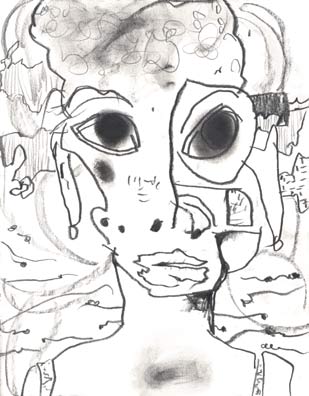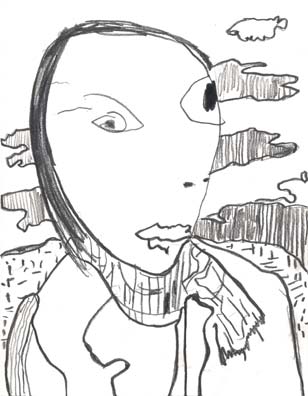
 |

To see two week's worth of process on the current (still very active) canvas click here. Quicktime 5.8 MB

Last Thursday, I was humming along confident in my world view that the declining birthrates among industrialized nations is at least one positive trend towards environmental sustainability when, suddenly, the New York Times published an article plainly intent on disabusing me of such a naive notion. The headline quickly set the tone: “Empty Maternity Wards Imperil a Dwindling Germany.”
Viewed through the lens of hospitals scrambling for maternity business, the story charts the declining birthrate in Germany and the “problems” this demographic shift presents. The second sentence gives you the gist:
“Empty baby beds are lined up against a wall like rental cars in an airport parking lot.”
In short, the German infrastructure is predicated on constant population growth with no other viable solutions to care for its elderly, according to the reporting of the New York Times.
Then, the article truly shows its hand:
“Mr. Schirrmacher and other commentators conjure up a sort of reverse Malthusian nightmare: Germany as a land of predominantly geriatric towns and cities set in a deserted, creeping countryside.”
Really? Evidently, one author’s “creeping countryside” is another’s “nature on the mend.” Addressing overpopulation on a global scale strikes me as one industrialized, trickle down mandate that has the potential to bode well for all species involved.
Humans, no matter how much the thought might make us bristle, remain part of nature. The declining birthrates seen not just in Germany but throughout the developed world represent an organically arising corrective to a system in stress.
In evolutionary terms, it marks an adaptive response to an unsustainable variety of consumption. That this demographic transformation contains at least an element of volitional choice (as well as sacrifice) is a stirring example of conscious evolution.
The Germans quoted in the the Times, however, not only failed to herald the environmentally aware choices of their national community, they burned the brand of guilt across the conscientious:
“ ‘They want their houses, they want their cars, they want their peace,’ she said, apologizing to her German roommate...“ ‘It is partly selfishness,’ Mr. Schönhoff agreed. ’They want a Mercedes, and it costs so much that they can't afford a child.’ ”
This accusation on page four while, three pages later, this appears.
Indisputably, Germany and all the many countries facing a future of aging populations with shrinking pools of younger workers have two monumental problems: national identity and maintaining economic responsibility for social systems. However, the need to reduce our collective ecological footprint, may begin altering - by necessity - long-accepted national structures.
With the population of the world at large continuing to grow and the upheavals headed our way courtesy of overpopulation’s global warming (to say nothing of the end of oil), these declining birthrates in certain enclaves of excessive consumption represent a budding solution to what ails us rather than the fearful cause of angst propagated by the New York Times.
Generating political imagination to redefine what it is to be “German,” “Italian,” “Spanish,” etc. while further opening borders to younger immigrants is one method by which world population can come into greater balance. Additional and more comprehensive solutions to what lies ahead can be found in the Earth Policy Institute’s book, Plan B and, interactively, at Conservation Economy.
In sum, make love not war and practice birth control.

In the quest to heal and, hence, truly win hearts and minds, two flourishing websites, Sorry Everybody and Apologies Accepted represent the emergence of a new and simple tool to bring forth change and understanding.
Born of despair over the U.S. election, the former consists of thousands of people extending personal expressions of apology to the world for the electoral outcome and its implications. The latter is the world’s response.
When official channels abandon diplomacy, the system adjusts and the people assume this role. This is humanpolitik vs. realpolitik. The expressions of kindness and sympathy are humbling, a reminder that people - in the main - are good and strive for the good.
These sites forge new ground: sunlight as an antidote to paranoia.
Consider the profundity this format represents: imagine sincere, creative apologies addressed between warring groups or across ethnic divides. The South African Truth and Reconciliation Commission comes to mind.
Who or what else deserves an apology?
What about a site that isn’t necessarily even addressed to other people but, say, to our planet’s water or soil, realtime apologies addressed to animals we’re driving to extinction or cultures now being eradicated or imperiled?
Can "Sorry Everybody" expand to engage dialogue this direct?
These sites’ use of digital photographs is a stroke of genius. Putting a face to the words removes sentiment from abstraction and is a face-by-face reminder of just what is at stake when we act in the world.
Lastly, a hallmark of humanity is sparked in joining the visual with the linguistic, unleashing the artistic impulse. (It can only be a good thing to practice a little art because when our SUVs are empty tanks on the freeway and there’s no more oil to be extracted, we’ll be left to mine the ultimate renewable resource: the artistry of human creativity.)
Who knows, enough sincere apologies joined with the appropriate adjustments of behavior may render today’s sorryeverybody.com, tomorrow’s thankseverybody.com.

The original "Enthroned Madonna" (1490) by Hans Memling resides in Das Suermondt-Ludwig Museum, Aachen. The version I've painted upon is a page from a fashion magazine that, absent my intervention, was headed to the landfill.